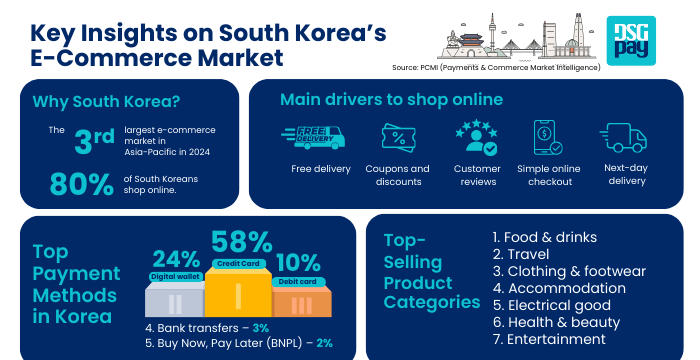The payment methods in Korea are quite broad and constantly changing. In 2024, the South Korean credit card market was predicted to surpass $770 billion, which is about a 6.3% growth in value.
If you’re taking a trip to Korea for business, school, or pleasure, it’s important that you first understand the state of the economy over here. For example, although some places collect cash as a payment method, Korea is mainly known as a cashless country.
In this article, we’ll explore the available payment methods in Korea, their advantages and disadvantages. We’ll also compare each method to help you pick the right option.
Let’s get into it!
Table of Contents
Key Takeaways
- Korea is rapidly becoming a cashless society with many businesses preferring digital money over physical cash.
- Card payments are widely used as a payment method in Korea, with over 58% of e-commerce transactions made using credit or debit cards.
- Digital wallets like Naver Pay, KakaoPay, and Toss are growing in popularity, facilitating over 24% of online transactions.
- Bank transfers and ATM Payments are also popular in Korea for local transactions.
- BNPL (Buy Now, Pay Later) services are also on the rise, but they are primarily available to residents with Korean-issued bank accounts.
Acceptable Payment Methods in Korea
Before we explore the acceptable payment methods in detail, let’s take a quick look at South Korea’s e-commerce market to understand the bigger picture.

Although Korea is a highly developed country, not all payment methods are acceptable there. When it comes to foreign transactions, you have to pay extra attention to the type and method of payment you’re using.
For example, Apple Pay was introduced to South Korea in 2023, and yet, only limited stores and banks accept it. Additionally, many small business owners do not accept foreign credit cards due to high processing fees.
Here are some of the most widely accepted payment methods in Korea:
1. Payment By Cards
One of the most widely used and accepted payment methods in Korea is card payment. They account for over 58% of e-commerce transactions in 2024. Most businesses, including restaurants, shopping malls, and convenience stores, accept and prefer card payments. However, not all international credit cards are supported, and some businesses may require a local-issued card.
If you’re going to South Korea, here’s a list of cards that are popularly used and accepted over there.
Popular Card Payment Methods in Korea:
- KB Kookmin Card: This is one of South Korea’s leading credit card providers. They are widely used for both domestic and international transactions.
- BC Card: This is the largest payment processing entity in South Korea. They have a reputation for offering comprehensive financial services.
- Shinhan Card: They are known for their extensive merchant network and compatibility with international payments.
- Samsung Card: This is a suitable option for local business owners in South Korea.
- Hyundai Card: They are popular for their strong rewards program and international payment capabilities.
- Lotte Card: They are frequently used for retail transactions, especially in Lotte-affiliated stores and duty-free shopping.
| Provider | Benefits | Shortcomings |
| KB Kookmin Card | – They are well-aligned with global transactions. – Known for their customer-centric features. | They may have limitations on certain international withdrawals. |
| BC Card | – Known as one of the largest merchant networks in South Korea. – Suited for international transactions. – Extensive Payment Network. | Not all foreigners can possess a BC Card due to its internal regulations. |
| Shinhan Card | – Internationally compatible. – Innovative product offerings, e.g., The BEST-X. | They have high foreign exchange fees. |
| Samsung Card | Linked with Samsung Pay (a major mobile wallet in Korea). | You need to have a Korean bank account to access such cards. |
| Hyundai Card | Attractive rewards and global acceptance. | Premium services are charged at higher annual fees. |
| Lotte Card | Ideal for retail shopping and duty-free purchases. | They have limited acceptance outside Lotte-affiliated merchants. |
2. Payment by Digital Wallets
Digital wallets are an increasingly popular payment method in Korea, especially among younger generations. Over 24% of online transactions are processed through digital wallets.
Popular Digital Wallets in Korea:
- Naver Pay: This is a popular mobile wallet linked to South Korea’s largest search engine, often referred to as “Google of South Korea”. Naver is also widely accepted for online purchases.
- KakaoPay: Integrated with KakaoTalk (Korea’s top messaging app), this wallet is known for its quick and easy peer-to-peer transfers.
- Toss: This is a fintech-based payment platform that allows for bank transfers and mobile payment solutions.
- Samsung Pay: This is a mobile payment solution compatible with NFC-enabled point-of-sale systems.
| Wallet | Benefits | Shortcomings |
| Naver Pay | – Extensive User Base. – Suitable for online and international payments. – Offers interest benefits and rewards. | High Merchant Fee. |
| KakaoPay | – Extensive client base. – Accepts loyalty cards, coupons, gift certificates, etc. | Charges an interchange fee of 1% for payment services. This may be higher compared to other services. |
| Toss | – User-friendly interface for simplified peer-to-peer transactions. – Offers investment opportunities. | Limited English support presents a challenge for non-Koreans. |
| Samsung Pay | – Broad compatibility, as it works with most POS terminals. – Allows digital credit card creation. | – Exclusive to Samsung device owners. – Supported in limited regions. |
3. Bank Transfers and ATM Payments
Bank transfers are one of the widely used payment methods in Korea. They are particularly used for online transactions and bill payments.
You can also use the ATM to send, receive, and withdraw money at your convenience.
Here are acceptable and popular methods under this category.
Major Banks in Korea:
- KEB Hana Bank: This is a popular financial institution, known as the largest and longest-running exchange bank in South Korea. They are quite common among expatriates due to their international capabilities across countries.
- Woori Bank: Founded in 1899, this bank offers extensive ATM services and online banking options mainly in the corporate finance and commercial banking sector.
- Shinhan Bank: Founded in 1982, this bank is known for its user-friendly mobile banking app. Operating as a part of Shinhan Financial Group, Shinhan Bank is a major banking institute in Korea.
- Kookmin Bank: This is one of Korea’s largest banks with a strong international presence.
- Citibank Korea: Established in 1983, Citibank offers a range of financial products and services for corporate and investment banking.
| Bank | Benefits | Shortcomings |
| KEB Hana Bank | – Strong foreign exchange services. – Popular among expatriates due to cross-border transfer capabilities. | – International transfer fees may be higher than fintech alternatives. |
| Woori Bank | – Highly trusted in South Korea. – Extensive ATM network. One of the most accessible banks for withdrawals across the country. | – Less foreigner-focused. – May require a Korean mobile number for full digital banking access. |
| Shinhan Bank | – International wire transfer support. – User-friendly mobile app. | – Higher FX transaction fees. – Language limitations in mobile app and website. |
| Kookmin Bank | – Supports cross-border transactions and overseas branches. – Offers wide ATM coverage and full-service banking. – Strong online banking and app interface. | – High bank fees for some international services. – Stringent KYC requirements for foreign customers. |
| Citibank Korea | – Global banking network. – English-friendly services. | – Limited physical branches. – Fewer ATMs compared to domestic banks. |

4. Payment by Installments and BNPL (Buy Now, Pay Later)
Installment payments are another widely accepted payment method in Korea. They are particularly applied to large purchases like electronics and home appliances. BNPL services are also growing in popularity, gaining 2% of e-commerce payment methods in Korea last year. This method allows consumers to spread payments over several months without interest.
Popular BNPL Platforms in Korea:
- KakaoPay Later: This is a deferred payment service linked to KakaoPay.
- Toss BNPL: They provide flexible instalment options for online shoppers.
- Naver Pay Installments: This method enables users to split payments over time without additional fees.
| Platform | Benefits | Shortcomings |
| KakaoPay Later | – Integration with Kakao Ecosystem. – User-Friendly Interface. | – Limited Merchant Acceptance. |
| Toss BNPL | – Flexible Installment Options. – Provides additional features like investment opportunities and financial management tools. | – May not be as widely accepted across all e-commerce platforms. |
| Naver Pay Installments | – Extensive User Base. – Competitive Merchant Fees (1.8 – 3.3% of the transaction value.) | – Currency Limitation. |
However, keep in mind that these services are primarily available to residents with Korean-issued bank accounts.
Concluding Thoughts on Payment Methods in Korea
Navigating Korea’s payment system as a foreigner or business owner requires that you understand the country’s acceptable payment methods. While credit cards, digital wallets, bank transfers, and BNPL services dominate the market, knowing the limitations of each international payment option is important to avoid inconvenience.
FAQs
How do foreigners pay in Korea?
Foreigners can pay using international credit cards, cash, digital wallets, and ATMs. However, not all international cards are accepted everywhere. For easier setup, use DSGPay to shop online and pay bills faster.
Can foreigners use Apple Pay in Korea?
Apple Pay is still limited to specific stores and banks in Korea. Samsung Pay is a better alternative.
Can I pay for taxis with cash in Korea?
Yes, you can. Most taxis also accept cash, credit/debit cards and T-money transportation cards.
Can I receive payments from Korean clients if I don’t live in Korea?
Yes. Through DSGPay, you can receive payments in KRW even without needing a Korean bank account. DSGPay gives you access to global virtual accounts, making it easy to collect funds from clients, marketplaces, or platforms in Korea.
An Alternative Payment Method for Foreigners and Global Business Owners in Korea
While Korea is rapidly becoming a cashless society with advanced domestic payment options, foreigners and international businesses often face friction when sending or receiving funds to and from South Korea, especially due to currency conversion issues, bank compatibility, or high international transfer fees.
DSGPay offers a global payment solution for individuals and companies who need to transact with South Korea’s local payment methods without needing a Korean bank account.
Why Choose DSGPay for Your Korea Transactions?
- Global Named Virtual Accounts: Open dedicated business accounts in your company’s name to send and receive local payments in Korea.
- Multi-Currency Support: With connections to over 30+ countries, DSGPay offers seamless conversion capabilities across multiple currencies, including KRW, USD, EUR, GBP, HKD, and more.
- Low Transaction Fees: DSGPay offers competitive exchange rates with no hidden markups.
- Cross-Border Collections & Payouts: Accept payments from customers, marketplaces, and platforms worldwide, and settle funds in the currency of your choice.
- Fast and Secure Transfers: Send and receive funds with real-time processing.
- Licensed & Regulated: DSGPay operates under a licensed Money Service Operator (MSO) in Hong Kong, aligning with international compliance and anti-money laundering (AML) standards.
If you’re a foreign resident, a cross-border seller, or a global brand looking to do business in Korea. DSGPay is your trusted gateway to Korea’s cashless economy.



